|
||||||
|
SONCHUS. Sow-thistles. [Asteraceae] |
|
|
Six species of Sonchus are recorded in Britain. These include the native Prickly Sow-thistle (S. asper), Smooth Sow-thistle (S. oleraceus), Perennial Sow-thistle (S. arvensis) and Marsh Sow-thistle (S. palustris). The BSBI provide a downloadable plant crib for the subspecies of Sonchus arvensis. Sixteen or seventeen British miners are recorded on Sonchus. The polyphagous agromyzids Liriomyza huidobrensis and Liriomyza trifolii have been recorded in quarantine in Britain (Pitkin & Plant in British leafminers). See also Liriomyza species in Glasshouses and/or Quarantine Interceptions. A key to the European miners recorded on Sonchus is provided in Bladmineerders van Europa. |
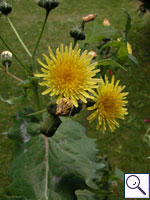 Smooth Sow-thistle Sonchus oleraceus |
Key for the identification of the known mines of British |
||
1a > Stem-miner: External stem-miner (Spencer, 1972b: 61). |
||
|
||
Phytoliriomyza arctica (Lundbeck, 1901) [Diptera: Agromyzidae]. |
||
1b > Leaf miner/galler: Circular, lower-surface blotch, about 5 mm in diameter, often quite a number together on a leaf. Upper surface wart-like, strongly reddish discoloured, opaque. At the lower surface the mine is closed only by the epidermis. The larva is easily visible, as is its food: drops of cell sap that oozes into the mine. Pupation sometimes in the mine, sometimes in the soil.. The blotches are also illustrated in British Leafminers. |
||
|
||
Cystiphora sonchi (Vallot, 1827) [Diptera: Cecidomyiidae]. |
||
1c > Leaf-miner |
||
2a > Leaf-miner: Mine primarily associated with the mid-rib. |
||
2b > Leaf-miner: Mine not primarily associated with the mid-rib. |
||
3a > Leaf-miner: A distinctive mine primarily above mid-rib, with irregular short lateral offshoots into leaf blade. Pupation external (Spencer, 1972: 51 (fig. 172), 55; Spencer, 1976: 270, 271 (fig. 486)). Branched, whitish, upper-surface corridor; main axis overlying the midrib; side branches overlying the main lateral veins. (In Campanula and Phyteuma the mine is much less branched, sometimes nothing more than a corridor on top of the midrib). Frass in rather long strings. Usually the mines begins as a long and narrow, shallow, tortuous lower-surface corridor that ends upon the midrib but otherwise is not associated with the leaf venation. Often this initial corridor is filled with callus, and then even less conspicuous. Pupation outside the mine. A linear mine on the upper surface, usually following the midrib and showing side branches along the veins. The frass is in strings. |
||
|
||
|
||
Liriomyza strigata (Meigen, 1830) [Diptera: Agromyzidae]. |
||
3b > Leaf-miner: A whitish blotch-mine along mid-rib, with offshoots into leaf blade. Pupation takes place at the base of the mid-rib. Puparium yellowish white |
||
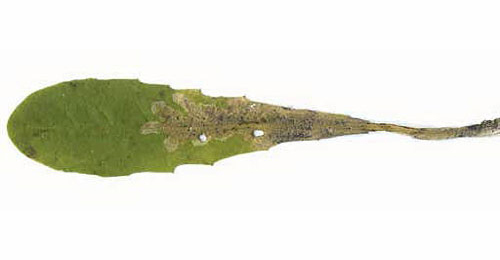 Mine of Ophiomyia cunctata on Taraxacum officinale Image: © Willem Ellis (Bladmineerders van Europa) |
||
|
||
Ophiomyia cunctata (Hendel, 1920) [Diptera: Agromyzidae]. |
||
3c > Leaf-miner: A whitish blotch-mine along the mid-rib, with lateral offshoots into the leaf blade. Pupation at base of leaf in petiole (Spencer, 1972b: 25). Broad corridor overlying the midrib, with short excursion into the blade, mainly in its basal part. Frass concentrated in the basal part of the mine, corridors almost free from frass. Pupation in the mine, also in the basal part. |
||
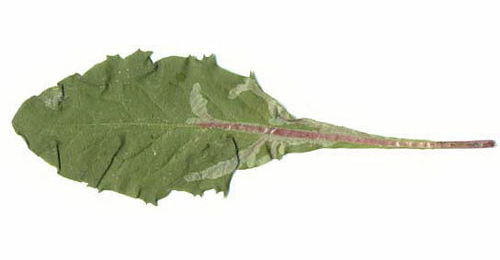 |
||
| Mine
of Ophiomyia pulicaria on Taraxacum officinale Image: © Willem Ellis (Bladmineerders van Europa) |
||
|
||
Ophiomyia pulicaria (Meigen, 1830) [Diptera: Agromyzidae]. |
||
3d > Leaf-miner: A white mine along mid-rib, with offshoots into leaf blade. Pupation internal at base of mid-rib. In Asteraceae the larva mostly lives as a borer in the midrib of the leaves. From there short corridors are made into the blade. Also a corridor can be made overlying the midrib. In Euphorbia a small mine is made in the bracts of the inflorescence. The final mine strongly resembles the one of Liriomyza strigata, but the branches are vritually free from frass; this is acccumulated in the resting place of the larva, in the base of the midrib. There also pupation takes place. Forms a mine along the midrib and has feeding spurs into the leaf. Pupation is in the mine at the base of the midrib. |
||
|
||
Ophiomyia beckeri (Hendel, 1923) [Diptera: Agromyzidae]. |
||
4a > Leaf-miner: Mine linear, whitish, both upper and lower surface. Pupation internal, at the end of the mine with the anterior spiracles projecting through the epidermis (Spencer, 1976: 433). Upper-surface, less often lower-surface corridor. Frass in isolated grains. Pupation within the mine, usually in a lower-surface puparial chamber. A long whitish upper surface corridor, which eventually goes lower surface. |
||
|
||
Chromatomyia
horticola (Goureau, 1851) [Diptera: Agromyzidae] |
||
4b > Leaf-miner: Larva mining both lower and upper surface, unusually long, linear, conspicuously broad, frequently largely on the underside of the leaf. Pupation external (Spencer, 1972b: 76 (fig. 251); Spencer, 1976: 445 (fig. 780), 446). Corridor mine. The first part consists of a very long and narrow lower-surface corridor; the mine is quite shollow here, and often inconspicuous. The second part is upper-surface, uusally much shorter, and widens abruptly. Pupation outside the mine. |
||
|
||
Phytomyza marginella Fallén, 1923 [Diptera: Agromyzidae]. |
||
4c > Leaf-miner: A small primary blotch, often several larvae feeding together (Spencer, 1972b: 56 (fig. 186); Spencer, 1976: 270, 271 (fig. 483)). Brown, upper-surfsce blotch; often several larvae in a mine. The blotch is preceded by a short initial corridor, often overrun by the later blotch. Frass in a few, small grains. Secondary feeding lines well visible. Pupation outside the mine, exit slit in upper epidermis. Small upper surface blotch, with occasional galleries leading from the blotch. Often several larvae feeding together. |
||
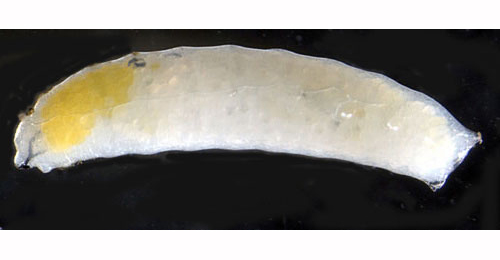 Liriomyza sonchi larva, lateral Image: © Willem Ellis (Bladmineerders van Europa) |
||
|
||
Liriomyza sonchi Hendel, 1931 [Diptera: Agromyzidae]. |
||
4d > Leaf-miner: A short, irregular, linear upper surface mine on any part of the leaf. Also recorded from young pods (Bland, 1997a). Long corridor mine. As a rule the first part of the mine is lower-surface, the later part upper-surface. Often the loops are so dense that a secondary blotch is the result. Because upper- and lower-surface corridor segments often cross, the mine obtains a strange array of transparant patches. There is no association with the midrib. Frass in strings and thread fragments. Pupation outside the mine; exit slit in upper epidermis. Mine not associated with the veins or midrib of the leaf (It is this character which enables distinction from another Agromyzid pest species - Liriomyza huidobriensis). The larvae may leave one leaf (if not large enough) and enter another leaf, via the petiole). It exits the leaf to pupate through a semi-circular slit in the upper surface of the leaf. |
||
|
||
Liriomyza bryoniae (Kaltenbach, 1858) [Diptera: Agromyzidae]. |
||
| 4e > Leaf-miner: A small somewhat irregular, elongate blotch. | ||
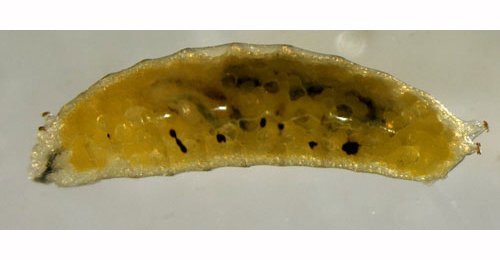 Liriomyza taraxaci larva, dorsal Image: © Willem Ellis (Bladmineerders van Europa) |
||
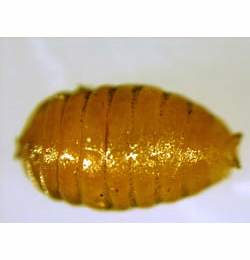 Liriomyza taraxaci puparium Image: © Willem Ellis (Bladmineerders van Europa) |
||
|
||
Liriomyza taraxaci Hering, 1927 [Diptera: Agromyzidae]. |
||
4f > Leaf-miner: A long, winding leaf-mine on the upper surface of the leaf, with frass widely-spaced in conspicuous black lumps. Pupation internal, at the end of mine (Spencer, 1972b: 28 (fig. 68), 29). |
||
|
||
Ophiomyia maura (Meigen, 1838) [Diptera: Agromyzidae]. |
||
4g > Leaf-miner: The mine begins with a very narrow full depth corridor, that ends upon the midrib. Subsequently a broad corridor, or rather an elongated blotch, is made overlying the midrib; from here broad, lobe-like extensions are made into the blade. Frass in discrete grains. Secondary feeding lines conspicuous. The larva is capable of leaving the mine and restarting in a new leaf, in which case the association with the midrib may be lost. Pupation after vacation of the mine. |
||
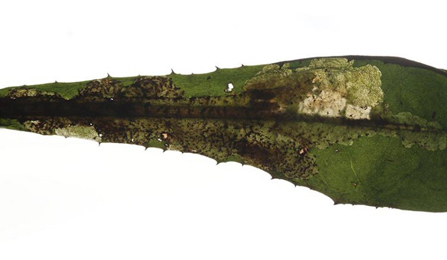 Mine of Trypeta immaculata on Taraxacum Image: Rob Edmunds (British leafminers) |
||
|
||
Trypeta immaculata (Macquart, 1835) [Diptera: Tephritidae]. |
||
|
Key for the identification of the known mines of British |
Note: The larvae of mining Coleoptera, Hymenoptera and Lepidoptera may live in a corridor mine, a corridor-blotch mine, a blotch mine, a case, a rolled or folded leaf, a tentiform mine or sandwiched between two more or less circular leaf sections in later instars. Larva may pupate in a silk cocoon. The larva may have six legs (although they may be reduced or absent), a head capsule and chewing mouthparts with opposable mandibles (see video of a gracillarid larva feeding). Larvae of Hymenoptera and Lepidoptera usually also have abdominal legs (see examples). Frass, if present, never in two rows. Unless feeding externally from within a case the larva usually vacates the mine by chewing an exit hole. Pupa with visible head appendages, wings and legs which lie in sheaths (see examples). |
1a > Leaf miner: In the first instar the larva mines the leaves, forming short, irregular, blotch-like mines, but in later instars it lives externally, feeding in spun leaves and often twisting those of tender shoots. Larval head light-brown or yellowish brown, edged with black postero-laterally, ocellar area blackish; prothoracic plate black edged with whitish anteriorly; abdomen dull dark green; pinacula distinct, black, sometimes brownish but with black bases to setae; anal plate large, black (Bradley et al., 1973). Small, full depth mine without a definite shape; little frass. Some silk is deposited in the mine. The larva soon leaves the mine and continues feeding among spun leaves. |
|
Cnephasia incertana (Treitschke, 1835) [Lepidoptera: Tortricidae]. |
1b > Leaf-miner: The mine begins in the midrib, especially in a lower leaf, extending into the leaf disc, branching irregularly or pinnately, may also locally be blotch like. The mine is brown and very transparent. Sides very irregularly eaten out. Frass loosely dispersed or in a loose central line, buy may also be pressed against the sides of the corridor. The larva may also leave the mine and restart elsewhere. |
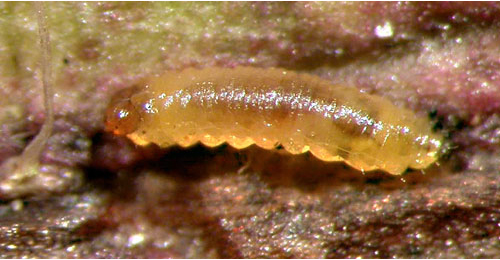 Orthochaetes setiger larva, dorsal Image: © Jean-Yves Baugnée (Bladmineerders van Europa) |
|
| Orthochaetes setiger (Beck, 1817) [Coleoptera: Curculionidae]. |
| Last updated 09-Jul-2020 Brian Pitkin | ||

